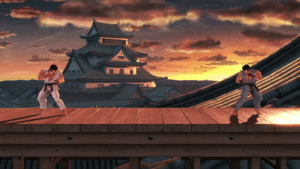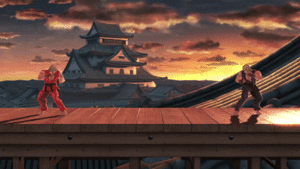| Hadoken | |
|---|---|
Hadoken in Ultimate. | |
| Users | Ryu Ken |
| Universe | Street Fighter |
Hadoken (波動拳, lit. Surge Fist) is Ryu and Ken's neutral special move.
OverviewEdit
Ryu brings his palms back beside himself to cup them together, then thrusts them forward in an instant to shoot out a large energy projectile while announcing the technique's name. Only one Hadoken per player can be in play at any given time; attempting a second Hadoken if the first one is still active will result in them performing the animation with only a puff of harmless smoke appearing from their hands. Shooting the projectile midair gives Ryu a tiny amount of lift, like Mario's Cape; this does not occur if Ryu fails to produce a projectile due to another one being in play.
As with most of Ryu's special moves, performing specific directional inputs allows Ryu to use stronger versions of the Hadoken (default, input and Shakunetsu). In addition, Ryu can control the speed and damage of the projectile depending on how long the player holds the special button down - tapping will fire a slower and weaker projectile, while holding will fire a faster and stronger projectile, mimicking the Light/Medium/Heavy mechanic of Street Fighter. In Ultimate, these projectile speeds are more prominent, with slow Hadokens having around two-thirds the speed of a normal one, and fast Hadokens having more than twice the speed, allowing more versatility in their use.
All versions of the Hadoken travel half of Final Destination's length; because of these properties, they are ineffective for KOing, but good for racking up damage at range, useful in Ryu's tilt combos, and can be used as a option to wall off opponent's approaches, albeit being less effective than other projectiles like Megavitamins due to the limit of one active Hadoken per player. All versions of Hadoken have extremely low priority and can be blocked by almost any attack, including extremely weak projectiles, which makes Hadokens easy to counter at a distance. Additionally, the projectile can miss certain crouching or prone characters due to its traveling height, while a select few can even run directly under one (such as Little Mac).
Ken, who is Ryu's Echo Fighter, shares this move. Aesthetically, his version has a slightly different shape and contains an image of his hands, similar to its appearance in Street Fighter II. Compared to Ryu, Ken's Hadoken is weaker, and its speed is less controllable due to it using Ryu's old Hadoken speeds from Smash 4; additionally, he does not have access to the Shakunetsu Hadoken.
Hadoken typesEdit
Standard HadokenEdit
| “ | A projectile from a world-class fighting game. Hold down the button to vary how fast it travels. It’ll disappear after a set distance. | ” |
| —In-Game Tip | ||
Pressing only the special button performs the standard Hadoken, a small blue energy projectile, while Ryu voices out "Hadoken!". It deals 5-6%, with low enough knockback that it can lock opponents.
Input HadokenEdit
| “ | Quickly input down, down-forward, forward for 1.25x power. You might have to practice a bit to really figure out howtodo a Hadoken. | ” |
| —In-Game Tip | ||
Inputting the original arcade input for the move (↓ ↘ → + attack/special) makes Ryu perform a stronger Input Hadoken, with him voicing out the attack with a fiercer voice. The projectile becomes slightly larger and stronger in the process, doing 6-7% damage, but still travels slowly with similar range as the original. The attack emits a tiny spark if the player successfully inputs it correctly, similar to the spark seen by fastfalling fighters. Ryu can also perform this while in standby after breaking the Smash Ball.
Shakunetsu HadokenEdit
| “ | Input back, down-back, down, down-forward, forward to unleash a fiery Shakunetsu Hadoken that can deal multiple hits. | ” |
| —In-Game Tip | ||
Performing the move while moving the control stick in a semicircle towards the direction Ryu is facing (← ↙ ↓ ↘ → + attack/special) will unleash a Shakunetsu Hadoken (灼熱波動拳, Scorching Heat Surge Fist). Ryu voices out "Shakunetsu!" as this Hadoken is unleashed. This variation is colored bright orange, deals multiple hits and flame damage before exploding upon hitting an opponent. The projectile deals the most damage out of all variants, especially in Ultimate (7-8% in Smash 4, 14.8% in Ultimate). Like other versions of the move, however, its knockback is weak and distance unchanged. The first hit doesn't make the opponent flinch, making it possible for them to shield the rest of the attack.
True to the series, Ken is unable to perform this attack, instead using Oosoto Mawashi Geri (大外回し蹴り, Big Outer Roundhouse Kick), a roundhouse kick from Super Street Fighter II Turbo. This move can be cancelled into his Inazuma Kick (稲妻かかと割り, Lightning Flash Heel Splitter), a heel-dropping axe kick on either hit or during the move's startup by holding the attack button.
CancelingEdit
Both Ryu and Ken can perform a Hadoken out of some normal attacks due to their special move canceling mechanic. By pressing the special button or doing the command input after connecting with a normal attack, Ryu and Ken will cancel the endlag of the normal attack and perform a Hadoken. The normal attacks that can be canceled include the first two hits of neutral attack, tapped and held down-tilt, tapped up-tilt, and proximity forward-tilt and held neutral attack (in Ultimate), to name a few. This allows them to deal extra damage in combos, improving their punish game.
In Ultimate, the command variants of Hadoken can themselves be cancelled into their user's Final Smash if close enough to an opponent.
Copy Ability (Kirby)Edit
Kirby can also perform all versions of the Hadoken once he Inhales Ryu or Ken, by inputting the same motion on the control stick. He voices out all attacks like Ryu as well, albeit in his more lighthearted voice; attempting to shoot a Hadoken while one is still in play makes Kirby voice out a short "Hoh!", unlike Ryu, who simply scoffs. Kirby can also perform the inputted and Shakunetsu Hadoken variants while in standby after breaking the Smash Ball. Interestingly, Kirby has different voice clips for Ryu and Ken's versions of Hadoken.
Instructional quoteEdit
| Move List | Fires an energy wave from his palms. Holding down the button increases its speed and power. | |
| Fires an energy wave from his palms. Holding down the button increases its speed and power. |
CustomizationEdit
Special Move customization was added in Super Smash Bros. 4. These are the variations:
- Hadoken: Default
Like the other DLC characters, Ryu lacks custom move variations.
OriginEdit
Hadoken, sometimes spelled as "Hadouken" and colloquially called a "fireball", is a special move available to several characters such as Ryu and Ken in the Street Fighter series. It involves the user thrusting their palms forward to fire a blue surge (yellow in the original Street Fighter) of spirit energy, or Ki. It is most commonly performed with ↓ ↘ → + light/medium/heavy punch. The projectile's speed, distance traveled, and recovery time increases the more powerful button is pressed. In a majority of games, users of this technique will have an image of their palms grafted onto the projectile itself when one looks at the projectile itself closely. The creator of Street Fighter, Takashi Nishiyama, credits the 1970s anime Space Battleship Yamato as the inspiration of Hadoken, based off of a weapon called Hadōhō (波動砲, lit. Wave Motion Gun/Surge Cannon). An oddity involving the Hadoken in early versions of Street Fighter II is that there was a 1/512 chance a regular input would perform a Hadoken instead. This was done to slowly introduce beginners to more advanced mechanics. However, it perplexed those that witnessed it, who believed it was a glitch for many years until dataminers discovered it was an intentional mechanic.
In the main Street Fighter series, Ryu, as well as other Hadoken practitioners, cannot perform a Hadoken in midair, but they can in some crossover games like Marvel Vs. Capcom, where it is known as the Kuchu Hadoken/Kuuchuu Hadouken (空中波動拳, Midair Surge Fist) in Ryu's case mainly.
The Shakunetsu Hadoken was formally introduced in Super Street Fighter II: The New Challengers as a new move for Ryu, a special red fireball that could burn the opponent. In the original Street Fighter II, the regular Hadoken occasionally turns red as an easter egg (originally thought to be a glitch). While the easter egg is purely an aesthetic change, rumors eventually circulated that this "red Hadoken" was stronger; Capcom thus decided to make the "red Hadoken" a separate move with actual differences in properties (such as knocking down up-close in the Street Fighter Alpha/Zero games). The main reason for this decision was to differentiate Ryu and Ken, who were functionally identical except for some minor moveset characteristics beforehand. In the Street Fighter III (excluding Street Fighter III: New Generation) and Street Fighter IV games, Shakunetsu Hadoken serves as Ryu's EX version of the move; Akuma being one practitioner of this attack still keeps it as a separate normal special move to this day, as he performs his signature focus stance as a delay before unleashing the move (Akuma's also has always done multiple hits prior to the EX move version).
Note that in Super Street Fighter II Turbo Ryu's Shinku Hadoken was also referred to as just the Hadoken, as none of the characters' Super Combos were properly named onscreen in their debut. This was changed in Street Fighter Alpha.
Like with many of Ryu's other moves/techniques, this is arguably the most codifying example of a projectile attack in any fighting game. While most games would only allow one copy of a projectile to be on-screen at a time, later games allow multiple copies of them to be on-screen. This is played straight for Ryu's Hadoken in Marvel vs. Capcom 3 with the latter case.
The Hadoken's size in Smash Bros. is more likely based off of the Marvel vs. Capcom series' version, where starting with X-Men vs. Street Fighter, several Street Fighter characters' moves were given radical changes in order to look less pale in comparison to the X-Men characters, with the Hadoken's size increase being one radical change out of many.
Though Ken has always used the Hadoken alongside Ryu, his usage of it is far more restricted, often being inferior in various aspects such as being punishable on hit when close to the opponent. He is characterized as being flashier and preferring kicks, leading to his Shoryuken being more powerful than Ryu's and forgoing the Shakunetsu Hadoken for other attacks like his Roundhouse Kicks.
GalleryEdit
Names in other languagesEdit
| Language | Name |
|---|---|
| Japanese | 波動拳 |
| English | Hadoken |
| French | Hadoken |
| German | Hadoken |
| Spanish | Hadoken |
| Italian | Hadoken |
| Chinese | Hadoken |
| Korean | Hadoken |
| Dutch | Hadoken |
| Russian | Хадокен |
TriviaEdit
- The Input Hadoken (including the Shakunetsu Hadoken) can still be performed while in Final Smash standby mode, making Ryu and Ken (and Kirby with Ryu/Ken's Copy Ability) the only fighters who can use a neutral special move in standby after breaking the Smash Ball, barring glitches and disc load delay.
- Kirby's appearance with Ryu's Copy Ability resembles Fighter Kirby, which in turn pays homage to Ryu. Various games allow Kirby to perform some of Ryu's other attacks, like the Shoryuken (as "Rising Break") and Tatsumaki Senpukyaku (as "Aerial Spin Kick"), and both Kirby's Return to Dream Land and Kirby Triple Deluxe allow Kirby to fire the Instant Mega Force Blast using the traditional Hadoken command, which is called "Hadou-Shot" in Japan.
- In Smash 4, the in-game tip for performing Hadokens erroneously spells the phrase "how to do" as a single word ("howtodo") for unknown reasons.

